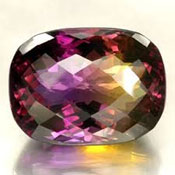Ametrine
(a-met-rine)
HISTORY and LORE
- Ametrine is a bicolor gem that’s highly prized when it displays an attractive balance between its most desirable amethyst and citrine shades.
- The world’s only commercial source of ametrine is the Anahi mine in southeastern Bolivia. Legend has it that a Spanish conquistador discovered the mine’s location in the 1600s and introduced the gem to Europeans when he presented several specimens to his queen. The mine had been given to him as a dowry when he married a native princess named Anahi.
- The mine was lost for over three centuries and rediscovered in the 1960’s . . . ametrine than began showing up on the market in the 1970’s.
VALUE FACTORS
- Color: Ametrine’s colors blend, combine, and contrast uniquely in each gem. Because of the unusual combination of Amethyst and Citrine, you will never find two gemstones exactly the same.
- Clarity: Often lightly included. Minor clarity characteristics are accepted.
- Cut: Faceted in many shapes and styles. Also cabochons, carvings, fantasy cuts, and beads. Unusual cutting styles add drama to ametrine’s unique color combination.
- Carat Weight: A wide range of sizes is available. Large material is popular with gem carvers.
TREATMENT
- Ametrine is not typically treated or enhanced. Amethyst is sometimes lightly heated or irradiated to produce artificial ametrine, but these enhancements are not very common. Synthetic ametrine does exist, but they are not commonly found because they are not in high demand. Despite ametrine being quite rare and sourced in only one locality, prices for ametrine are still very affordable.
GEMOLOGY
- Ametrine is variety of quartz, the most abundant mineral species in the Earth’s crust. Other quartz varieties include amethyst, citrine, rose quartz, smoky quartz, and tiger’s eye.
- Composed almost entirely of silicon and oxygen; chemical formula SiO2. Color caused by trace amounts of iron. (Note that this is the same chemical formula for Amethyst and Citrine separately)
CARE
Ametrine generally has good wearability.
- Hardness: Moderate scratch resistance. Rates 7 on the Mohs Hardness Scale.
- Toughness: Good resistance to chipping and breaking.
- Stability: Might fade if exposed to intense light (like direct sun) for a long time. Otherwise, no routine concerns for gem owners.
- Cleaning: Liquid cleaner, or detergent and water. Ultrasonic is usually safe, unless noticeable clarity characteristics are present.
